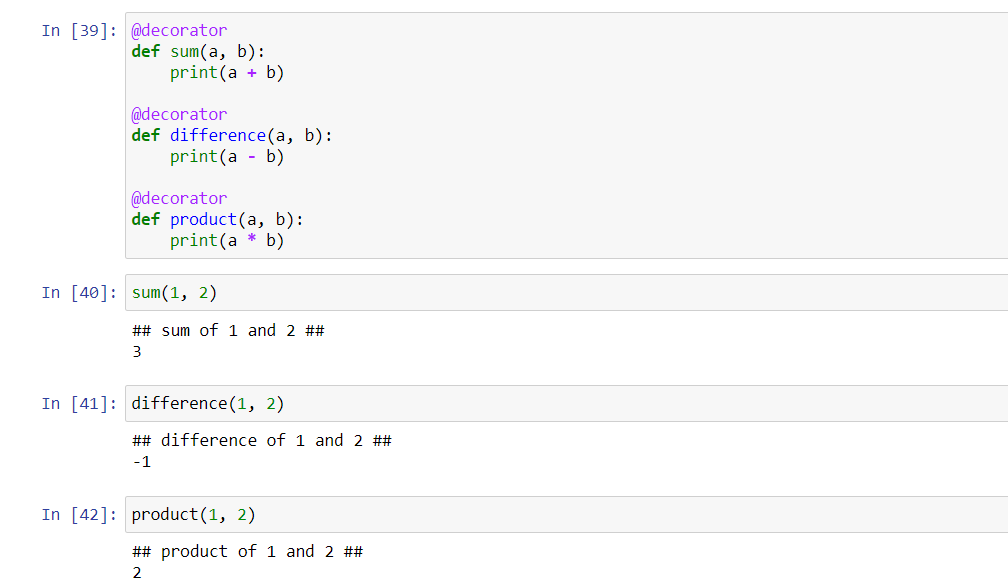Python装饰器实战:打造优雅函数,从原理到实践!
发布时间: 2024-09-20 17:09:33 阅读量: 319 订阅数: 47 


# 1. Python装饰器的原理
Python装饰器是一种用于修改或增强函数或方法功能的技术,它通过在原有函数的基础上包装一层新的函数实现。装饰器的主要思想是将函数作为参数传递给另一个函数,从而在不改变原函数代码的情况下,为函数添加新的功能或行为。
## 装饰器的工作机制
装饰器在Python中实质上是一个函数,该函数接受一个函数作为参数,并返回一个新的函数。下面的代码展示了装饰器最基础的结构:
```python
def my_decorator(func):
def wrapper():
print("Something is happening before the function is called.")
func()
print("Something is happening after the function is called.")
return wrapper
@my_decorator
def say_hello():
print("Hello!")
say_hello()
```
在这个例子中,`my_decorator`是一个装饰器,`say_hello`函数被`my_decorator`装饰。装饰器中定义了一个名为`wrapper`的新函数,它包含了对原始`func`函数的调用,并且在调用前后增加了额外的操作。
## 装饰器的优势
装饰器的优点在于其代码复用性和可插入性。它们可以在不修改原有函数的情况下增加功能,使得代码更加模块化和易于维护。装饰器在实际项目中的应用非常广泛,比如用于日志记录、性能监测、权限控制等方面。在后续章节中,我们将详细探讨如何定义和使用装饰器,以及它们在实际应用中的具体例子。
# 2. 装饰器的使用和自定义
在Python编程中,装饰器是一种强大的语法,它允许程序员在不修改函数定义的情况下增加函数的功能。这一章将详细介绍如何使用装饰器,并探讨自定义装饰器的多种方法。
## 2.1 装饰器的定义和语法
装饰器本质上是一个函数,它接受一个函数作为参数并返回一个新的函数。装饰器可以用于许多场景,比如日志记录、性能监控、权限检查等。
### 2.1.1 无参数装饰器
无参数装饰器是最简单的装饰器形式,它不接受任何额外的参数。下面是一个无参数装饰器的定义:
```python
def my_decorator(func):
def wrapper():
print("Something is happening before the function is called.")
func()
print("Something is happening after the function is called.")
return wrapper
@my_decorator
def say_hello():
print("Hello!")
say_hello()
```
在这个例子中,`my_decorator` 是装饰器本身,它定义了一个内部函数 `wrapper`,这个内部函数在被装饰的函数执行前后添加了一些额外的行为。使用 `@my_decorator` 语法可以应用装饰器。
### 2.1.2 带参数装饰器
在某些情况下,我们希望装饰器能够接受参数,以便根据不同的参数执行不同的逻辑。下面是一个带参数的装饰器的示例:
```python
def decorator_with_args(number):
def my_decorator(func):
def wrapper(*args, **kwargs):
print("Something is happening before the function is called.")
result = func(*args, **kwargs)
print("Something is happening after the function is called.")
return result
return wrapper
return my_decorator
@decorator_with_args(10)
def say_hello(name):
print(f"Hello {name}!")
say_hello("Alice")
```
这里 `decorator_with_args` 是一个接受参数的外层函数,它返回一个内层的装饰器 `my_decorator`,而 `my_decorator` 最终返回包装函数 `wrapper`。装饰器可以根据传递给 `decorator_with_args` 的参数(本例中为数字10)来调整其行为。
## 2.2 装饰器的常见用途
装饰器用途广泛,不仅可以用于简单的日志记录,还可以用于安全、性能优化等许多方面。
### 2.2.1 登录验证
登录验证是Web开发中常见的功能,装饰器可以用来确保用户在调用特定函数前已经登录。这通常通过检查用户的会话或令牌来实现。
```python
from flask import request
def login_required(func):
def wrapper(*args, **kwargs):
if not request.cookies.get('session'):
return "Login required", 401
return func(*args, **kwargs)
return wrapper
@login_required
def get_user_profile(user_id):
return {"user_id": user_id, "profile": "User profile data"}
```
### 2.2.2 性能监控
性能监控装饰器可以帮助开发者了解函数的执行时间和性能瓶颈。这通常用于性能调优和生产环境监控。
```python
import time
def performance_monitor(func):
def wrapper(*args, **kwargs):
start_time = time.time()
result = func(*args, **kwargs)
end_time = time.time()
print(f"{func.__name__} took {end_time - start_time} seconds")
return result
return wrapper
@performance_monitor
def slow_function():
time.sleep(1)
return "Done"
```
## 2.3 装饰器的高级用法
装饰器还可以进一步嵌套使用或递归应用,以实现更复杂的编程模式。
### 2.3.1 装饰器嵌套使用
在某些情况下,可能需要将多个装饰器应用到同一个函数上。Python允许装饰器嵌套使用,而且顺序很重要。
```python
def outer_decorator(func):
def wrapper():
print("Outer decorator wrapper")
func()
return wrapper
def inner_decorator(func):
def wrapper():
print("Inner decorator wrapper")
func()
return wrapper
@outer_decorator
@inner_decorator
def my_function():
print("Hello, decorators!")
my_function()
```
### 2.3.2 装饰器的递归应用
递归应用装饰器是较为高级和复杂的概念。它涉及到装饰器自身的重复应用,或者创建一个装饰器链,使得一个装饰器可以多次应用于同一个函数。
```python
def repeat_decorator(num_times):
def decorator(func):
def wrapper(*args, **kwargs):
for _ in range(num_times):
result = func(*args, **kwargs)
return result
return wrapper
return decorator
@repeat_decorator(3)
def say_hello(name):
print(f"Hello {name}!")
say_hello("Bob")
```
在这个例子中,`repeat_decorator` 接受一个参数 `num_times`,表示函数应被重复执行的次数。当你调用 `say_hello` 函数时,它会被重复三次执行。
通过上述章节的介绍,我们可以看到装饰器的灵活性和强大功能,它们使得Python代码更加模块化和复用性更强。在下一章中,我们将更深入地了解装饰器在实践中的应用案例,进一步体会装饰器的威力。
# 3. 装饰器实践案例分析
## 3.1 缓存装饰器的实现
### 3.1.1 使用functools.lru_cache优化性能
在处理计
0
0





